The Coinage Act of 1864 was a United States federal law passed on April 22, 1864, which changed the composition of the one-cent coin and authorized the minting of the two-cent coin. The Director of the U.S. Mint developed the designs for these coins for final approval of the Secretary of the Treasury. As a result of this law, the phrase "In God We Trust" first appeared, on the 1864 two-cent coin. An Act of Congress, passed on March 3, 1865, allowed the Mint Director, with the Secretary's approval, to place the phrase on all gold and silver coins that "shall admit the inscription thereon." In 1956, "In God We Trust" replaced "E Pluribus Unum" as the national motto. All currency was printed and minted with the new motto. [1]

The cent, the United States of America one-cent coin, often called the "penny", is a unit of currency equaling one one-hundredth of a United States of America dollar. It has been the lowest face-value physical unit of U.S. currency since the abolition of the half-cent in 1857. The first U.S. cent was produced in 1787, and the cent has been issued primarily as a copper or copper-plated coin throughout its history. Due to inflation, pennies have lost virtually all their purchasing power and are often viewed as an expensive burden to businesses, banks, government and the public in general.

The Coinage Act of 1873 or Mint Act of 1873 was a general revision of laws relating to the Mint of the United States. By ending the right of holders of silver bullion to have it coined into standard silver dollars, while allowing holders of gold to continue to have their bullion made into money, the act created a gold standard by default. It also authorized a Trade dollar, with limited legal tender, intended for export, mainly to Asia, and abolished three small-denomination coins. The act led to controversial results and was denounced by critics as the "Crime of '73".

"In God We Trust" is the official motto of the United States as well as the motto of the U.S. state of Florida, along with the nation of Nicaragua. It was adopted by the U.S. Congress in 1956, replacing E pluribus unum, which had been the de facto motto since the initial design of the Great Seal of the United States.

E pluribus unum – Latin for "Out of many, one" – is a traditional motto of the United States, appearing on the Great Seal along with Annuit cœptis and Novus ordo seclorum which appear on the reverse of the Great Seal; its inclusion on the seal was suggested by Pierre Eugene du Simitiere and approved in an act of the Congress of the Confederation in 1782. While its status as national motto was for many years unofficial, E pluribus unum was still considered the de facto motto of the United States from its early history. Eventually, the U.S. Congress passed an act in 1956, adopting "In God We Trust" as the official motto.

A nickel is a five-cent coin struck by the United States Mint. Composed of cupronickel, the piece has been issued since 1866. Its diameter is 0.835 inches (21.21 mm) and its thickness is 0.077 inches (1.95 mm).

The two-cent piece was produced by the Mint of the United States for circulation from 1864 to 1872 and for collectors in 1873. Designed by James B. Longacre, there were decreasing mintages each year, as other minor coins such as the nickel proved more popular. It was abolished by the Mint Act of 1873.

The Liberty Head nickel, sometimes referred to as the V nickel because of its reverse design, is an American five-cent piece. It was struck for circulation from 1883 until 1912, with at least five pieces being surreptitiously struck dated 1913. The obverse features a left-facing image of the goddess of Liberty.
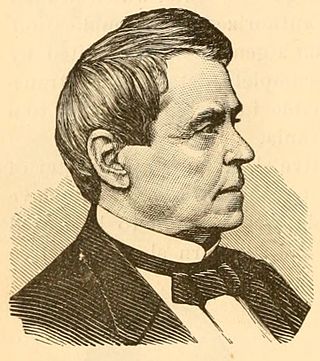
James Pollock was the 13th governor of Pennsylvania from 1855 to 1858.

The Coinage Act of 1792, passed by the United States Congress on April 2, 1792, created the United States dollar as the country's standard unit of money, established the United States Mint, and regulated the coinage of the United States. This act established the silver dollar as the unit of money in the United States, declared it to be lawful tender, and created a decimal system for U.S. currency.
Coinage Act is a stock short title used for legislation in the United Kingdom and the United States related to coinage.

The American twenty-cent piece is a coin struck from 1875 to 1878, but only for collectors in the final two years. Proposed by Nevada Senator John P. Jones, it proved a failure due to confusion with the quarter, to which it was close in both size and value.

The Seated Liberty dollar was a dollar coin struck by the United States Mint from 1840 to 1873 and designed by its chief engraver, Christian Gobrecht. It was the last silver coin of that denomination to be struck before passage of the Coinage Act of 1873, which temporarily ended production of the silver dollar for American commerce. The coin's obverse is based on that of the Gobrecht dollar, which had been minted experimentally from 1836 to 1839. However, the soaring eagle used on the reverse of the Gobrecht dollar was not used; instead, the United States Mint (Mint) used a heraldic eagle, based on a design by late Mint Chief Engraver John Reich first utilized on coins in 1807.

The Shield nickel was the first United States five-cent piece to be made out of copper-nickel, the same alloy of which American nickels are struck today. Designed by James B. Longacre, the coin was issued from 1866 until 1883, when it was replaced by the Liberty Head nickel. The coin takes its name from the motif on its obverse, and was the first five-cent coin referred to as a "nickel"—silver pieces of that denomination had been known as half dimes.
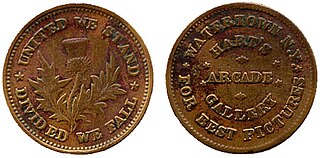
Civil War tokens are token coins that were privately minted and distributed in the United States between 1861 and 1864. They were used mainly in the Northeast and Midwest. The widespread use of the tokens was a result of the scarcity of government-issued cents during the Civil War.
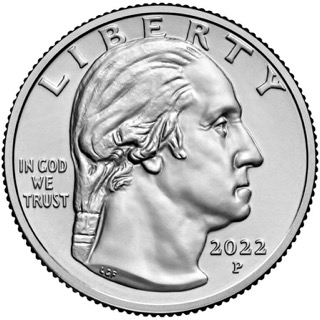
The Washington quarter is the present quarter dollar or 25-cent piece issued by the United States Mint. The coin was first struck in 1932; the original version was designed by sculptor John Flanagan.

The Lincoln cent is a one-cent coin that has been struck by the United States Mint since 1909. The obverse or heads side was designed by Victor David Brenner, as was the original reverse, depicting two stalks of wheat. The coin has seen several reverse, or tails, designs and now bears one by Lyndall Bass depicting a Union shield. All coins struck by the United States government with a value of 1⁄100 of a dollar are called cents because the United States has always minted coins using decimals. The penny nickname is a carryover from the coins struck in England, which went to decimals for coins in 1971.

The Indian Head eagle is a $10 gold piece or eagle that was struck by the United States Mint continuously from 1907 until 1916, and then irregularly until 1933. The obverse and reverse were designed by sculptor Augustus Saint-Gaudens, originally commissioned for use on other denominations. He was suffering from cancer and did not survive to see the coins released.
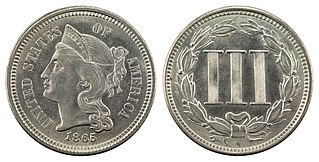
The copper-nickel three-cent piece, often called a three-cent nickel piece or three-cent nickel, was designed by US Mint Chief Engraver James B. Longacre and struck by the United States Bureau of the Mint from 1865 to 1889. It was initially popular, but its place in commerce was supplanted by the five-cent piece, or nickel.
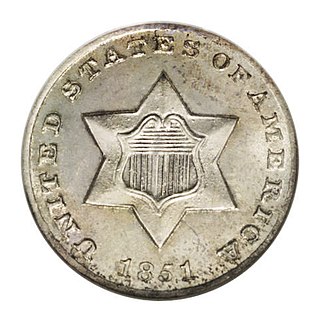
The three-cent silver, also known as the three-cent piece in silver or trime, was struck by the Mint of the United States for circulation from 1851 to 1872, and as a proof coin in 1873. Designed by the Mint's chief engraver, James B. Longacre, it circulated well while other silver coinage was being hoarded and melted, but once that problem was addressed, became less used. It was abolished by Congress with the Coinage Act of 1873.

The Illinois Centennial half dollar is a commemorative 50-cent piece struck by the United States Bureau of the Mint in 1918. The obverse, depicting Abraham Lincoln, was designed by Chief Engraver George T. Morgan; the reverse, based on the Seal of Illinois, was by his assistant and successor, John R. Sinnock. Morgan's obverse is based on the statue by Andrew O'Connor.